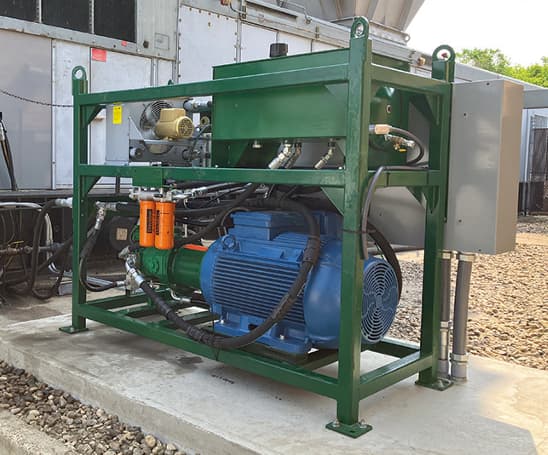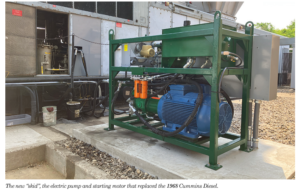Starting motor failure spurs Marshall’s creative solution
Editor’s Note: After a starting motor failure on a turbine on January 6, 2023, it took a team effort to get things humming again. MMUA sat down with Curt Anton, lead plant operator, Tony Mead, electrical operations manager and Scott Mellenthin, purchasing and property coordinator, to talk about this daunting project. Read article here.
MMUA: Tell me about the turbine that needed repair. What are its specs? When was it installed?
Scott: Marshall Municipal Utilities (MMU)’s Frame 5, 16,550-kilowatt (kW) generator was purchased in 1968 and installed at its current site in March of 1969.
MMUA: What broke on the turbine?
Scott: On January 6, 2023, during a routine exercise run, the turbine’s diesel starting motor had a catastrophic failure. Engine coolant and motor oil were expelled through all exhaust ports. The unit was shut down, all spilled substances were cleaned up, and the process of repair began immediately.
MMUA: Was it immediately clear what was wrong? How did you go about the process of determining the best path forward for this older machine?
Scott: The diesel starting motor portion of the turbine was the issue; all other turbine components were still intact and operable. The process of repairing the existing motor or finding a compatible replacement starting motor package began almost immediately. S.T. Cotter Turbine Services of Clearwater, Minnesota, was contacted to become the general contractor in this process. By January 19th, the entire starting motor was removed and on its way to S.T. Cotter’s facilities to begin the tear down and inspection process. Upon opening the engine, the liner, rings, and pistons were all deemed to be damaged or suspect. Repair of the existing unit soon proved to be almost impossible due to the lack of replacement parts and the age of the machine. After two months of exhaustive searching for options and coming up empty, it was suggested we contact a hydraulic/electric service contractor from Tulsa, Oklahoma. Discussion began with Hydra Services regarding the type and size of the starting unit that would be required to effectively replace the failed motor with a new electric-driven hydraulic motor package.
MMUA: Tell me about the unique repair and upgrade you did to the turbine. How did you come up with the plan?
Curt: Once it was determined it was not feasible to repair the current starting diesel, everyone started searching for other answers. S.T. Cotter got in touch with Hydra Service, and the idea of a hydraulic/electric starter started to form. Hydra Service came on site and determined the torque/ horsepower needed to start the turbine rotating and get to ignition speed. Once that was known, the process of procuring the needed components, manufacturing custom mounts, starting clutch, and assembly began. MMU crews began installing a dedicated electric service for the new starting system. This occurred in early April, and all components were on site by May 8. S.T. Cotter, Hydra Service, HPI Controls, and MMU started installation on May 10, with the first rotation occurring on the 11. The turbine had its first ignition with the new system on May 13. We had some tweaking to do yet, but MMU was able to meet the goal of the system being available for warm weather if needed by June 4.
MMUA: What parts did you need? How was availability for parts that were needed?
Curt: MMU’s turbine hydraulic/ electric starting package now consists of a three-phase 225KVA 277/480-volt transformer, a 250-horsepower electric motor with soft start, Linde hydraulic pump, and a hydraulic motor that is coupled to the GE turbine with a custom mount and shaft adapted to the GE accessory gear using HPI turbine controls. These have a custom fuel/rpm curve that was designed by a collaborative effort by HPI, Hydra Service, and MMU personnel.
Scott: MMU’s contractors pulled together to expedite the process of acquiring needed parts from many different plants throughout the country. The clock was ticking on the rebuild right from the start, and everyone did a fantastic job of reaching out to contacts and acquiring parts in an amazingly short period of time. It would not have been possible without everyone working together: S.T. Cotter Turbine Service-Clearwater MN, Magnuson Machining- St Louis MO, Hydra Service- Tulsa OK, HPI Energy Service-Houston TX, MMU staff, and tremendous local support also, especially from Heartland Electric, BendRite Fabrication, RDO, Ziegler, and Titan Machinery.
MMUA: Did the upgrade change the output of the turbine?
Scott: The unit has been operated several times since repair was completed. While maximum output has not been requested from the unit at this point, MMU has been very pleased with the results so far. Initial start up time has been slightly reduced, which is a pleasant surprise. Start up is a cleaner, quieter process. MMU, S.T. Cotter, Hydra Services, and MMU’s existing controls contractor HPI Energy Services all partnered together in this ground-breaking repair process. No one knew for sure that this would work when it was first proposed. But all parties came together to design, engineer, and incorporate an entirely new system that so far has put MMU back online and prepared to once again provide vital generation to its power suppliers when requested.
Tony: Overall, the outcome of this project has been very successful. Right from the beginning our staff dug in and was determined to find a solution by either repairing the existing diesel starting engine or finding one of similar displacement to take its place. This exact engine was widely used in the 60s and early 70s in Steiger tractors and military equipment, and we quickly found that all the overhaul kits had been used. Additional kits basically no longer existed. Many phone calls were made around the United States and even to other countries in an attempt to procure the same diesel engine. We quickly found that basically everyone else with this same unit was in the same predicament. S.T. Cotter, as our general contractor on the project, started pulling in information on utilizing an electric motor incorporated with hydraulics to crank the turbine. Once we chose to change course and incorporate the electric motor, the process moved along rather quickly considering the scope of work involved. The team from Hydra Service designed the “skid” that housed the new starting equipment to be placed next to the turbine rather than in the original engine compartment, which now basically only contains the small hydraulic motor that interconnects to the turbine shaft. Once incorporated, there was some trial and error with hydraulic flow and controls to create the perfect starting curve. Now that it is dialed in, it’s amazing to see how smooth and quick the startup process is.
MMUA: The news came out yesterday that Marshall will be getting a 500,000 square foot chemical facility. What are the possible impacts on Marshall’s electric use or the utility writ large?
Tony: Our community received confirmation recently that Solugen will be building their new Bioforge 2 facility in Marshall adjacent to ADM, a corn processing plant. Solugen has a process that converts plant- derived substances, such as dextrose from corn, into essential materials that have traditionally been made from fossil fuels. Starting out Solugen’s load will be approximately 3 MW at 85 percent or greater load factor, and they already have visions of expansion in the future, calling this the “initial phase.” They are planning offsite construction in late 2023 and plan to be operational in early 2025.



